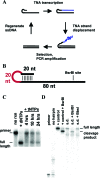An in vitro selection system for TNA
- PMID: 15740086
- PMCID: PMC5072288
- DOI: 10.1021/ja045364w
An in vitro selection system for TNA
Abstract
(3'-2')-alpha-l-Threose nucleic acid (TNA) is an unnatural polymer that possesses the rare ability to base-pair with RNA, DNA, and itself. This feature, coupled with its chemical simplicity, makes TNA of interest as a possible progenitor of RNA during the early history of life. To evaluate the functional potential of TNA, we have developed a system for the in vitro selection of TNA. We identified the Therminator DNA polymerase as a remarkably efficient DNA-dependent TNA polymerase capable of polymerizing more than 50 tNTPs. We have also developed a method of covalently linking a DNA template to the TNA strand that it encodes, thus obviating the need for a TNA-dependent DNA polymerase during cycles of selection.
Figures


Similar articles
-
DNA polymerase-mediated DNA synthesis on a TNA template.J Am Chem Soc. 2003 Jan 29;125(4):856-7. doi: 10.1021/ja028589k. J Am Chem Soc. 2003. PMID: 12537469
-
TNA synthesis by DNA polymerases.J Am Chem Soc. 2003 Aug 6;125(31):9274-5. doi: 10.1021/ja035917n. J Am Chem Soc. 2003. PMID: 12889939
-
An In Vitro Selection Protocol for Threose Nucleic Acid (TNA) Using DNA Display.Curr Protoc Nucleic Acid Chem. 2014 Jun 24;57:9.8.1-19. doi: 10.1002/0471142700.nc0908s57. Curr Protoc Nucleic Acid Chem. 2014. PMID: 24961723 Review.
-
Kinetic analysis of an efficient DNA-dependent TNA polymerase.J Am Chem Soc. 2005 May 25;127(20):7427-34. doi: 10.1021/ja0428255. J Am Chem Soc. 2005. PMID: 15898792 Free PMC article.
-
Threose nucleic acid as a primitive genetic polymer and a contemporary molecular tool.Bioorg Chem. 2024 Feb;143:107049. doi: 10.1016/j.bioorg.2023.107049. Epub 2023 Dec 20. Bioorg Chem. 2024. PMID: 38150936 Review.
Cited by
-
Biologically stable threose nucleic acid-based probes for real-time microRNA detection and imaging in living cells.Mol Ther Nucleic Acids. 2022 Jan 3;27:787-796. doi: 10.1016/j.omtn.2021.12.040. eCollection 2022 Mar 8. Mol Ther Nucleic Acids. 2022. PMID: 35116190 Free PMC article.
-
High fidelity TNA synthesis by Therminator polymerase.Nucleic Acids Res. 2005 Sep 12;33(16):5219-25. doi: 10.1093/nar/gki840. Print 2005. Nucleic Acids Res. 2005. PMID: 16157867 Free PMC article.
-
Effect of stalling after mismatches on the error catastrophe in nonenzymatic nucleic acid replication.J Am Chem Soc. 2010 Apr 28;132(16):5880-5. doi: 10.1021/ja100780p. J Am Chem Soc. 2010. PMID: 20359213 Free PMC article.
-
Synthesis and polymerase activity of a fluorescent cytidine TNA triphosphate analogue.Nucleic Acids Res. 2017 Jun 2;45(10):5629-5638. doi: 10.1093/nar/gkx368. Nucleic Acids Res. 2017. PMID: 28472363 Free PMC article.
-
A synthetic genetic polymer with an uncharged backbone chemistry based on alkyl phosphonate nucleic acids.Nat Chem. 2019 Jun;11(6):533-542. doi: 10.1038/s41557-019-0255-4. Epub 2019 Apr 22. Nat Chem. 2019. PMID: 31011171 Free PMC article.
References
Publication types
MeSH terms
Substances
Grants and funding
LinkOut - more resources
Full Text Sources
Other Literature Sources

